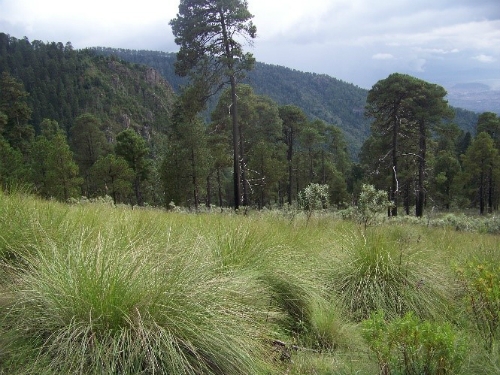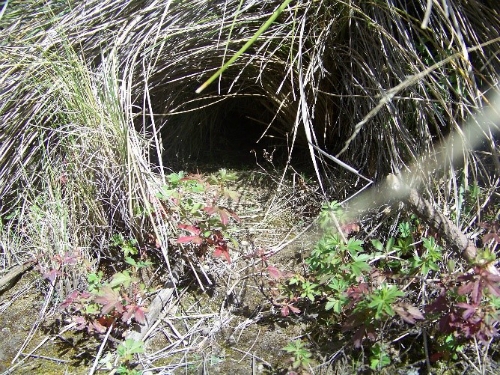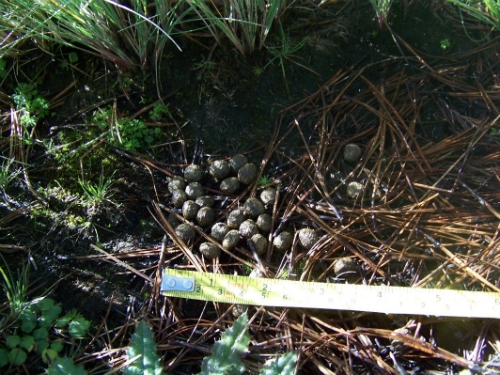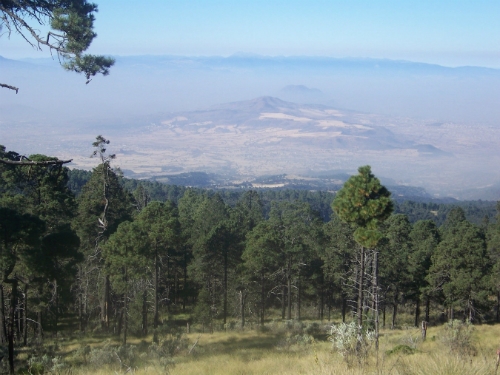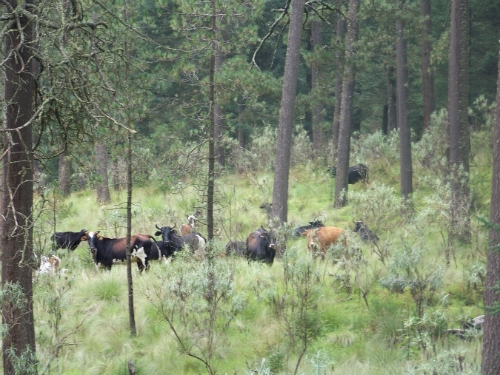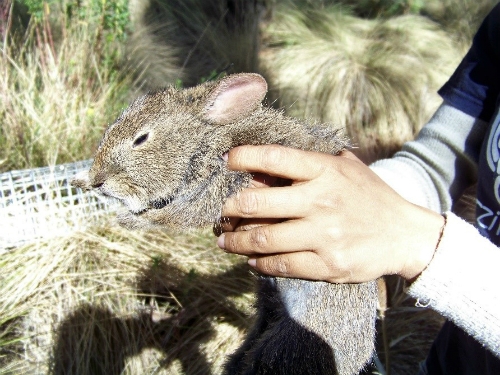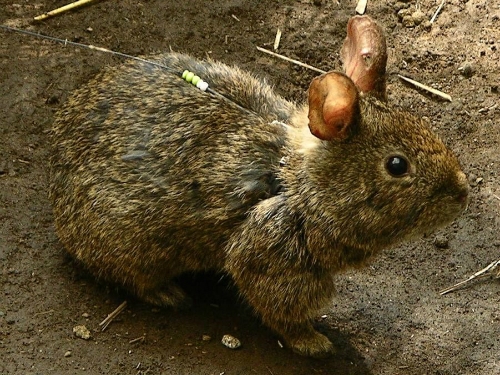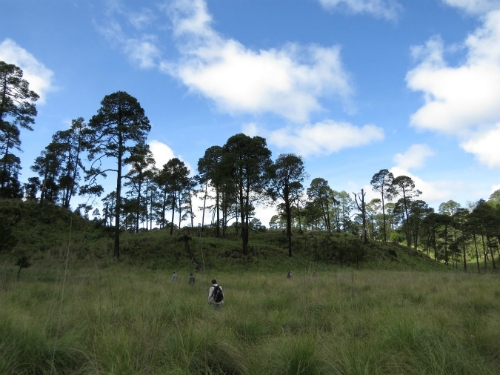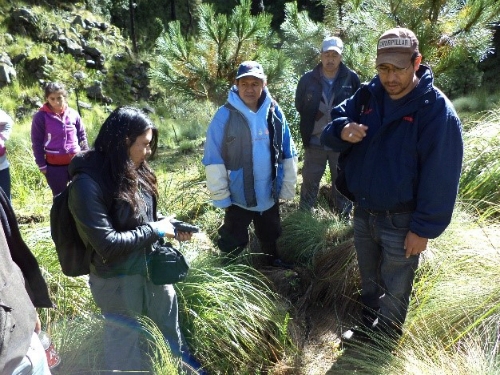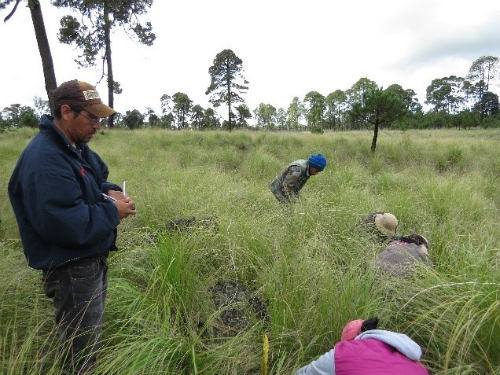Yajaira García is one of our newest Nat Geo Photo Ark EDGE Fellows, who will soon be starting her project focused on the volcano rabbit in Mexico. We asked Yajaira to write this blog to introduce herself, her project, and explain what an EDGE Fellowship means to her.
The challenges of being a rabbit that does not look like a rabbit
In general, when we think of a rabbit, a small animal with long ears and a white tail eating carrots comes to mind. We assume for them to be numerous because they have so many offspring over a short period of time, hence the phrase “breed like rabbits”.
However, not all rabbits are like that, and one example is the zacatuche (Romerolagus diazi, volcano rabbit) whose local name comes from náhuatl (native language of central Mexico). It means “rabbit of the bunch grass”, and emphasizes the dependence that the rabbit has on its habitat because it can only survive in pine forests with bunchgrasses on the mountains of central Mexico.

Volcano rabbits live between 2800 and 4250 meters above sea level in these pine forests (known as zacatones) in the central region of the Trans-Mexican Volcanic Belt, mainly on the slopes of the volcanoes of the Sierra Nevada (Popocatépetl and Iztaccíhuatl, mainly) and of the Sierra del Chichinautzin (Tláloc and Pelado).
The volcano rabbit is like a little teddy. It’s ears and legs are short and its tail is not visible. It’s the second smallest rabbit in the world with an adult weighing just 500 grams, and it’s the only rabbit that can vocalise. Since its first appearance on earth it has retained its characteristics without almost any change, and for this reason it is considered a ‘living fossil’. In addition to not resembling a common rabbit this species doesn’t reproduce like a rabbit either, since it has very small litters with an average of only two young.

Although the volcano rabbit has been on earth since before man even existed it is today on the brink of extinction due to humans. Urban development, agricultural expansion, grazing and logging have caused the reduction and fragmentation of the volcano rabbit’s habitat and illegal hunting and predation by exotic species such as dogs have decreased their populations.
Remaining populations are geographically and genetically separated by roads, farming areas and human settlements, which constitutes a serious threat to the survival of the species. In addition, climate change could reduce its habitat in the lower parts of its distribution. Due to the threats that this rabbit faces, both national and international governments consider this species in danger of extinction.
Despite its evolutionary and ecological importance in Mexico not many people know about “zacatuches” or its threats. In my case I knew nothing about them until my bachelor’s degree in Biology. I was amazed by the volcano rabbit’s biological and ecological characteristics but at the same time its alarming situation worried me profoundly. It wasn’t until 2008 that I started studying the species for my masters degree, which I still do to date. During all these years I have had the opportunity to research the ecology of this species, first in the field and later in captivity.
I’m convinced that the volcano rabbit´s protection in the long term will be achieved only if local communities (ejidatarios and comuneros, owners of the land) are involved in conservation actions in collaboration with governmental authorities and academic institutions. It is also necessary to carry out environmental education programs that allow people to know about the biological, ecological and cultural importance of the volcano rabbit.
For this reason, the Nat Geo Photo Ark EDGE Fellowship has given me the opportunity to carry out a project that will encourage the local community to participate in monitoring the volcano rabbit population at Milpa Alta (southeast of Mexico City) as well as to initiate an environmental education program that promotes its conservation.
The conservation of the volcano rabbit and its habitat will also make it possible to ensure the survival of other species that coexist with it, such as the mountain sparrow (Xenospiza baileyi), the mountain hen (Dendrortyx macroura) and the lynx (Lynx rufus), to name a few; and it will allow local communities to maintain the biodiversity of their forests.

Yajaira García is a Mexican biologist whose main interest is the conservation and ecology of mammals. For her Master’s degree she worked on the volcano rabbit and two other species of lagomorphs that share habitat on the northern site of the Sierra Nevada, Mexico. Her work has focused on the wild and captive colonies of volcano rabbit. The information that she has gathered has refined her methodology and research.
She has also contributed to a number of research projects at UNAM (Universidad Nacional Autonóma de México) focused on the biology and ecology of volcano rabbits. She has participated in initiatives with governmental institutions such as the National Commission of Protected Areas (CONANP), National Commission for the Knowledge and Use of Biodiversity (CONABIO) and General Management of Zoos and Wildlife (Dirección General de Zoológicos y Vida Silvestre DGZVS) and the academy to implement a monitoring system for volcano rabbits across their range.
Since 2012, she has worked as an environmental consultant in a non-governmental organization (NAME) where she has lead workshops to assess the local opinion and attitudes towards the modification and creation of protected areas by CONANP. Alongside her work on protected areas she has been measuring the impact of different incentive mechanisms to encourage sustainability in Mexico.
In 2018 Yajaira was awarded a NatGeo PhotoArk EDGE Fellowship. This award allows her to assess the population ecology of volcano rabbits at Milpa Alta, Mexico City and implement a communitarian survey. Yajaira sees the EDGE Fellowship as an opportunity to expand her knowledge of conservation biology, and to exchange ideas and experiences with people who are interested in the conservation of vulnerable species in different parts of the world.
